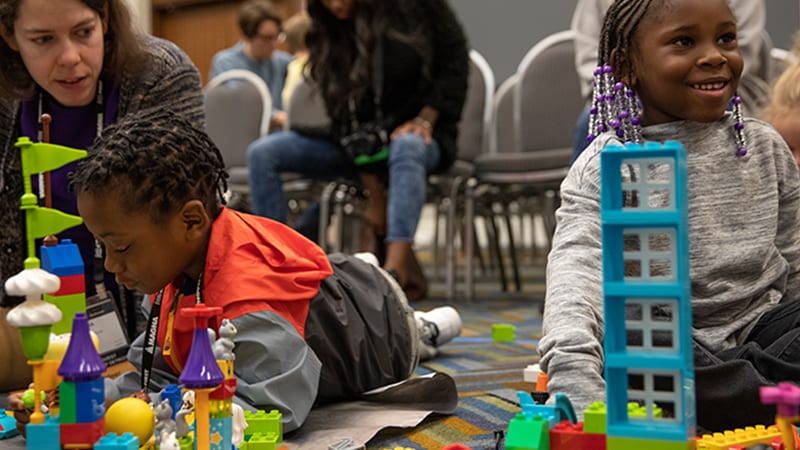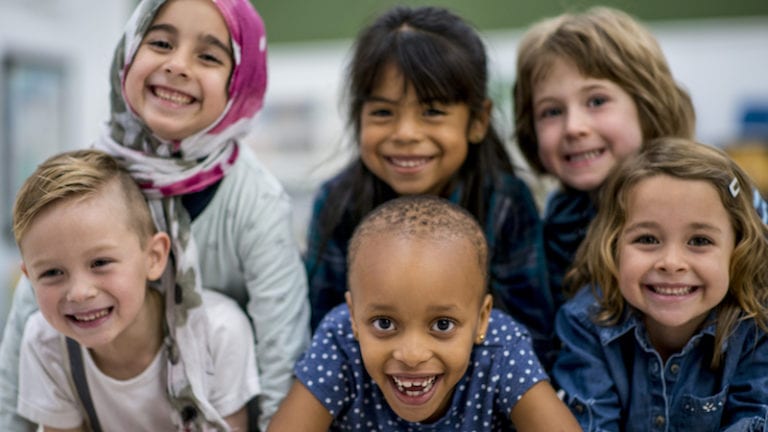We all know that early childhood is the prime time for learning language skills. Now mounting evidence suggests that STEM in Early Childhood Education is just as crucial for students’ later success. And, it turns out, language learning and STEM learning share some key characteristics.
STEM in Early Childhood Education happens alongside language learning.
It seems that young children possess a remarkable readiness for “real” STEM learning. One study cited by the NAEYC demonstrates that young children can engage in the same science practices as high schoolers. When presented in a developmentally-appropriate way, they can make predictions, carry out experiments, and collect data.
Early STEM experiences have the power to build an understanding of the important principles in STEM-related fields. Research on the potential benefits of block play found that kids with more building experience, like those who participate in FIRST® LEGO® League Jr. Discovery Edition, were more likely to tackle a building task from the bottom up. The bottom-up approach emphasizes participation by having children select their own goals and the means for reaching those goals. This approach also fosters community ownership which helps build social-emotional skills.
Language and STEM learning both happen through experience—and they complement each other.
Both STEM and language learning are rooted in an ongoing cycle of wondering, noticing, testing, and revising theories. Children generate ideas about the rules of language and then adjust them over time based on feedback and further experience. “Leafs growed” eventually becomes “Leaves grew.”
With STEM, children build an understanding when immersed in experiences that invite them to touch, build, create, and observe. A child who fills containers with soapy bubbles in the sink will learn about volume and capacity as well as the properties of liquids in the water table at school, in the bathtub, and at the swimming pool. Later, they may implement the same habits to test different variables in a lab experiment.
STEM in Early Childhood Education also improves social-emotional learning skills
Hands-on STEM activities encourage habits of mind like curiosity, problem-solving, creativity, and perseverance—which are essential for later success in adulthood. Communication skills further enhance these habits. When working in a group, a child building a block city is more successful when they can articulate to their peers, “Put the pointy pieces on top of the squares to make more houses.” This skill becomes an advantage to an engineer who needs to clearly convey an idea to a colleague.
Lisa Guernsey, who translates research on early childhood for policymakers and education leaders and assisted in the development of FIRST LEGO League Jr. Discovery Edition, found that an understanding of how the world works further assists in listening and reading comprehension. “Children have great opportunities to learn words and gain background knowledge as they get involved in hands-on projects—whether it is building bridges or talking about how rockets land on the moon. That knowledge will help them with reading comprehension and literacy as they get older, whether they are reading a book about outer space or communicating about an engineering problem.”
Intentional scaffolding is key for both STEM and language learning.
Just like language learning is optimized in a language-rich environment, STEM learning improves when adults’ offer thoughtful questions, a shared sense of wonder, and provision of time and materials to explore, according to research reviewed by the Center for Childhood Creativity.
Similarly, students don’t give up on an epic marble run because they aren’t exactly certain of how to do it. They strategize and revise their approach until achieving that coveted successful plop. When teachers bring out different materials to try, they encourage learning about motion, structures, design, and perseverance.
Both STEM and language learning opportunities are widespread.
Developmentally appropriate opportunities for young children to engage with STEM experiences once reserved for older students are also becoming much more readily available and accessible. FIRST LEGO League Jr. Discovery Edition lets even Pre-K through First Grade students experience the benefits of competing on a robotics team. Starting early to engage children in experiences that build the kind of thinking skills that will benefit everyone down the road? That’s something worth talking about.
Learn more about bring FIRST LEGO League Jr. Discovery Edition to your classroom. >>>

